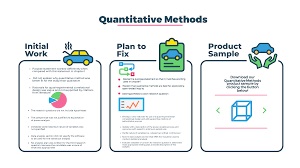Explanation
Quantitative methods in planning involve the application of statistical, mathematical, and computational techniques to analyze data and make informed decisions in urban and regional planning. These methods enable planners to systematically evaluate and predict the impacts of various policies, projects, and developments. Here are the key components and applications of quantitative methods in planning:

Data Collection and Analysis
- Surveys and Questionnaires: Collecting data on demographics, housing, transportation, and other variables.
- Census Data: Using population and economic data to understand trends and needs.
- Geographic Information Systems (GIS): Mapping and spatially analyzing data to visualize patterns and relationships.
Statistical Analysis
- Descriptive Statistics: Summarizing data using measures like mean, median, and standard deviation to understand the central tendencies and variability.
- Inferential Statistics: Making predictions or generalizations about a population based on sample data, using techniques like regression analysis, hypothesis testing, and confidence intervals.
Modeling and Simulation
- Urban Growth Models: Predicting future development patterns based on current trends and policy scenarios.
- Traffic and Transportation Models: Simulating traffic flow and transportation systems to optimize infrastructure and reduce congestion.
- Environmental Impact Models: Assessing the potential impacts of development projects on the environment.
Optimization Techniques
- Linear Programming: Solving problems related to resource allocation, land use planning, and transportation planning by optimizing an objective function subject to constraints.
- Multi-Criteria Decision Analysis (MCDA): Evaluating and prioritizing different planning options based on multiple criteria, often involving stakeholder input.
Forecasting
- Population Projections: Estimating future population growth and distribution to plan for housing, services, and infrastructure.
- Economic Forecasting: Predicting economic trends to guide economic development strategies and policy decisions.
Spatial Analysis
- Hot Spot Analysis: Identifying areas with high concentrations of particular phenomena, such as crime or pollution, to target interventions.
- Network Analysis: Analyzing transportation and utility networks to improve connectivity and efficiency.
Gains of Quantitative Methods in Planning
Informed Decision-Making
- Data-Driven Insights: Quantitative methods provide planners with empirical evidence to support their decisions, reducing reliance on intuition or anecdotal evidence.
- Objective Evaluation: These methods enable objective assessment of different planning scenarios, helping to identify the most effective solutions.
Predictive Accuracy
- Future Planning: Accurate forecasting and modeling help planners anticipate future needs and challenges, allowing for proactive rather than reactive planning.
- Risk Mitigation: Identifying potential risks and their impacts enables planners to develop strategies to mitigate those risks effectively.
Efficiency and Optimization
- Resource Allocation: Quantitative methods optimize the use of resources, ensuring that investments in infrastructure, services, and development are cost-effective and yield the highest benefits.
- Operational Efficiency: Streamlining processes and improving the efficiency of transportation, utilities, and other systems reduce costs and enhance service delivery.
Stakeholder Engagement
- Transparency: Providing data and quantitative analyses to stakeholders enhances transparency and trust in the planning process.
- Collaborative Planning: Quantitative methods facilitate collaboration by offering a common, data-driven basis for discussions and decisions.
Sustainability and Resilience
- Environmental Planning: Quantitative methods assess the environmental impacts of development projects, promoting sustainable practices and minimizing negative effects on the ecosystem.
- Resilience Planning: Modeling and simulation help planners design resilient systems that can withstand and recover from disasters and other disruptions.
Economic Benefits
- Economic Growth: Data-driven economic forecasting and planning attract investments, stimulate economic activity, and create jobs.
- Cost Savings: Efficient resource allocation and optimization reduce waste and save costs in the long term.
Policy Development and Evaluation
- Evidence-Based Policies: Quantitative analyses provide the foundation for developing policies that are effective, equitable, and justifiable.
- Impact Assessment: Evaluating the impacts of existing policies and programs helps refine and improve them, ensuring they meet their objectives.
In summary, quantitative methods in planning are essential tools that enhance the accuracy, efficiency, and effectiveness of urban and regional planning. They provide a scientific basis for decision-making, optimize resource use, and contribute to sustainable and resilient development, ultimately improving the quality of life for communities.



